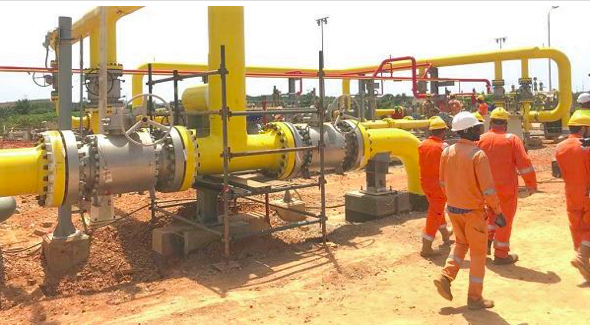Special topics

The project, which was completed ahead of schedule and within cost, is expected to pave the way for more reliable energy supply to power plants in Tema and Aboadze, as well as serve non-power gas users.
Following the completion of the tie-in, Ghana Gas is now producing 110 million standard cubic feet (mscf) a day, which can generate about 600 megawatts (MW) of power for the country.
The visit
A team of officials from Ghana Gas and journalists went on a tour of the Aboadze power plant at Aboadze yesterday.
During the tour, the Communications Officer of Ghana Gas, Mr Ernest Owusu-Bempah, confirmed that the tie-in had been completed ahead of schedule and that what was left were some civil works that would be completed soon.
“The major work involving the tie-in and push gas to the Volta River Authority has been done. At the moment we are doing about 110mscf a day, which can generate about 600MW of power. What is left are some civil works that will be done soon,” he said.
Power outage
The completion of the tie-in is expected to help reduce or eliminate the sporadic power outages the country is currently experiencing as a result of the shutdown and other technical challenges.
After the tie-in, the facility now has an integrated port system, which positions it to serve any plant — both power and non-power customers — in the enclave without shutting down to carry out a future hook-up to the metering station.
Stranded gas
Mr Owusu-Bempah said with the completion of the tie-in, stranded gas would now flow to the plants in Tema for power generation.
Stranded gas is essentially gas that is wasted or unused. Meanwhile, Ghana has had to pay for gas produced by Eni-Ghana, whether it uses the gas or not. That arrangement is part of the contract between Ghana and Eni-Ghana for the Sankofa gas production
Currently, through the Takoradi metering and regulation station, 110mscf of gas is delivered to the VRA thermal plants at Aboadze daily.
Daily Graphic checks indicate that out of the 110mscf, VRA is only consuming about 100mscf because some of its generating units are being maintained.
Demand of gas
The facility, henceforth, is best placed to distribute about 225mscf through the lines to the Tema enclave through the reverse line connection, while a total volume of 150mscf goes to VRA facilities.
From the same metering station, engineers explained, a total volume of 90mscf would be delivered to the Karpowership after its relocation to Sekondi in June. Amandi Energy would also be supplied with 90mscf.
The manufacturing sector, a ceramic factory in the enclave, is using about 10mscf to power its operations.